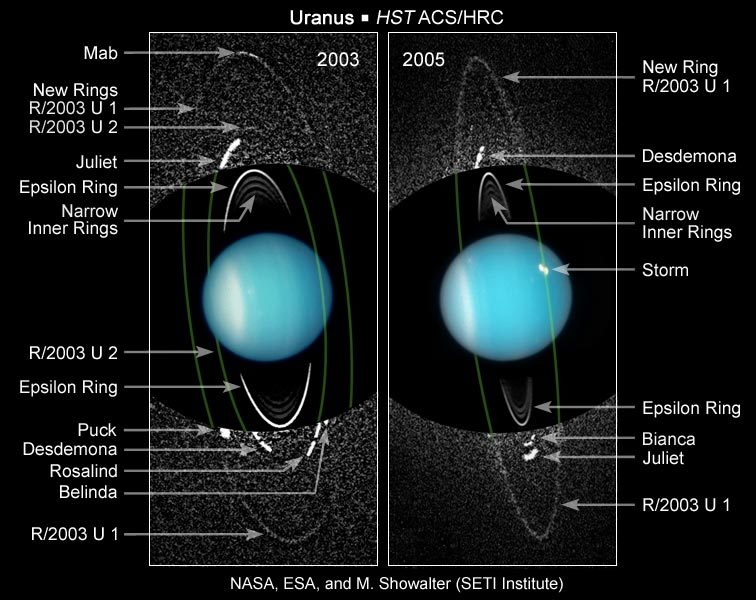
Hubble: Newly Discovered Moons and Rings of Uranus (Annotated)
These composite images from several observations by NASA's Hubble Space Telescope reveal a pair of newly discovered rings encircling the planet Uranus. The left composite image is made from Hubble images taken in 2003. The new dusty rings are extremely faint and required long exposures to capture their image. The background speckle pattern is noise in the image. The outermost ring (R/2003 U 1) is likely replenished by dust blasted off a newly discovered satellite called Mab, embedded in the ring and visible as a bright streak at the top of the outer ring. The new outermost ring is twice the radius of the previously known ring system around Uranus, as seen near image center. (The inner rings are much brighter, so no noise is visible in the background). Approximately halfway between the outermost ring and inner ring system is a second newly discovered ring (R/2003 U2). Only a faint segment of it appears at the 12:00 o'clock position. Because of the long exposures, the moons are smeared out and appear as arcs within the ring system. This image also shows the positions of Uranus's other known satellites. The earliest Uranian moons discovered were primarily named for fairies and sprites taken out of English literature, and that trend continued through Voyager's discovery of Puck (from Shakespeare's A Midsummer Night's Dream) in late 1985. When the number of moons discovered by Voyager became so large, the rules were generalized so that names from traditional English literature could be used. Therfore the moons have names like Juliet, Rosalind, Ophelia, Cordelia, etc. The Hubble team actually identified the name Mab (Queen Mab the fairies' midwife in Romeo and Juliet) before their first Hubble observation, in the likelihood new moons would be discovered. Besides being a Roman god, Cupid is also a character in Shakespeare. In the image at right, taken two years later, the rings appear more oblique because Uranus has moved along its solar orbit. The planet Uranus itself is approaching spring equinox, when the Sun will be directly shining over the planet's equator in 2007. Cloud bands and storms are becoming more pronounced in the atmosphere. A bright storm appears at northern latitudes in the 2005 images. The images were taken with the Advanced Camera for Surveys, using a clear filter.
